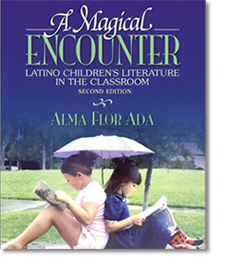Creative Reading: A Transformative Education Approach
 A complete description of this methodology can be found in A Magical Encounter. Latino Children’s Literature
A complete description of this methodology can be found in A Magical Encounter. Latino Children’s Literature
in the Classroom. This book offers suggestions for all steps in the use of literature in the classroom, from the preparing to share
a book, the various forms of reading and the creative dialogue to oral, written, artistic and dramatic responses
to books.
Some highlights are the Creative Reading Methodology, The One Thousand Books Classroom and the suggestions
for Culminating Activities, Author’s Study, and on-going Self-Evaluation.
.
Effective Reading: A Dialogue Between Reader & Text
Effective reading goes beyond finding out what is written on a page. It is indeed a dialogue between reader and text in which the reader
contributes as much as the text.
Reading is more than a source of information and entertainment. It is an empowering act.
Reading provides the opportunity of understanding self and others.
It can be a source of courage, dignity, kindness, generosity and hope to act as a more capable protagonist of one’s own life.
There are four aspects, which we have called phases, to an effective reading act. They do not happen independently, but simultaneously,
although here we present them independently to make them more clearly understandable.
Descriptive Phase:
In this initial moment the reader understand the content of the text.
What? When? Where? Who? Why? These are questions asked by the reader and answered by the text.
Personal Interpretive Phase:
The reader responds to the text with feelings and emotions based on the reader’s real life experiences in circumstances
related to,/by similarity or opposition, to the text. The reader validates (or questions, or expands) her/his experience
with information from the text.
How do I feel about this? Who do I know that has experienced something similar? How has my own
experience differed? What would I do…? How would I feel?
The type of questions to guide the dialogue in this phase would be of the nature of:
Have you ever seen [known] something like this?
If this were your family, how would things have been different?
Have you felt something like the author describes? Or in a similar situation, how have you felt?
Critical/Multicultural/Anti-Bias Phase:
The reader engages in critical reflection.
Is this right (moral, appropriate, healthy, kind, courageous, generous, just, equitable)?
Who benefits (suffers) from these conditions? What would be the consequences if all would adopt this
idea (behavior)?
In which way would diverse people (of different ethnicity, culture, genre, age, sexual orientation,
physical ableness, class, education) react to this?
Do these concepts allow for human diversity? Do they take it into account?
The type of questions to guide the dialogue in this phase would be of the nature of:
Who benefits in a situation like this? Who suffers?
Has anyone been excluded from this text? Who is left out? Why?
What are the author’s intentions? Is there a point the author tries to prove?
Creative/Transformative Phase:
The reader is moved to action by the text. Having read this text:
What do I know now that will empower me? In which ways do I understand my reality better?
How can I act to transform my inner self? My social reality?
The type of questions to guide the dialogue in this phase would be of the nature of:
What can you do in a situation like the one in the text?
In which ways would you speak/act differently now?
How can you improve your life/conditions/relations?
This is a description of the intent of the four phases. The actual questions should be precise, related to the text, and
presented in a language accessible to the students.
The questions provided for each of the chapters of YES! WE ARE LATINOS are inspired by this methodology. All questions offered
are mere suggestions. We encourage you to create your own.
